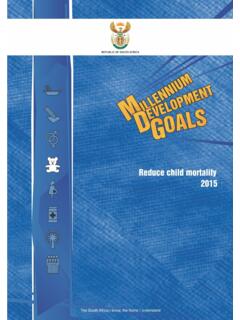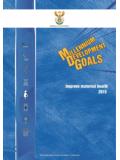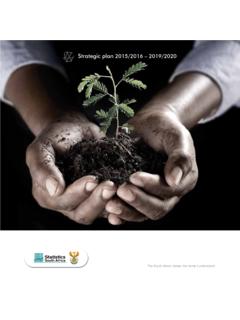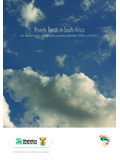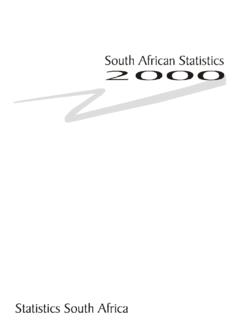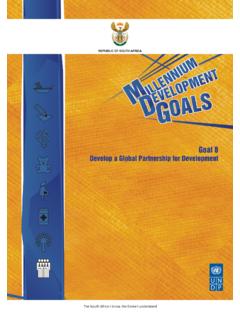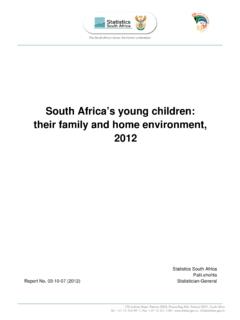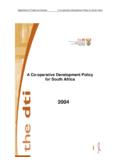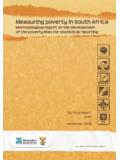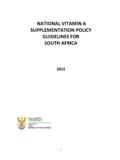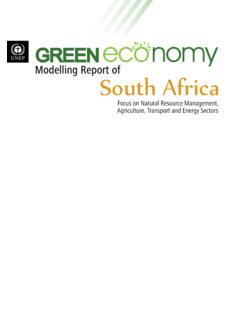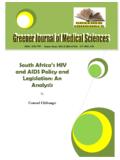Transcription of The South Africa I know, the home I understand 1 | P a g e
1 The South Africa I know , the home I understand 1 | P a g e The South Africa I know , the home I understand 2 | P a g e millennium development Goals, Country Report 2013 / Statistics South Africa Published by Statistics South Africa , Private Bag X44, Pretoria 0001 Stats SA Library Cataloguing-in-Publication (CIP) Data millennium development Goals, Country Report 2013 / Statistics South Africa . Pretoria: Statistics South Africa , 2013 140pp ISBN 978-0-621-42181-1 The South Africa I know , the home I understand 3 | P a g e FOREWORD Minister Trevor Manuel, the Minister in the Presidency: The National Planning Commission We are in the home stretch, 2015 is just around the corner and this millennium development Goals report, the fifth in a series of reports since the adoption of the MDG s in 2000, is critical in understanding and knowing whether we are going to achieve all the goals by 2015.
2 It is important to reiterate that South Africa was always a willing signatory to the MDGs because it aligned itself seamlessly with a vision expressed and supported by millions of South Africans when they assembled in Kliptown in 1955, which they called the Freedom Charter which became an important base document to South Africa 's supreme law, the Constitution. It is therefore, true to say that the goals were an integral part of the on-going work and challenges taken on by the post-apartheid government. It is also instructive to note that this commitment is the bedrock of Vision 2030 as it is espoused in our National development Plan: By 2030, we seek to eliminate poverty and reduce inequality. We seek a country wherein all citizens have the capabilities to grasp the ever-broadening opportunities available. Our plan is to change the life chances of millions of our people, especially the youth; life chances that remain stunted by our apartheid history.
3 (National development Plan, p5). But as this report so vividly illustrates, there are still so many challenges in our endeavour to ensure that we achieve the MDG goals. We are confident that we have dealt effectively with the goal to half extreme poverty but we remain deeply concerned that relative inequality remains high, as measured by the Gini coefficient. This is so in part because of the high unemployment rate and the low labour force participation rate in our country. The current report also shows that we have gone beyond the achievements related to the universal access to education, to also include indicators on the efficiency, quality and outputs of the education system. The seeming paucity of good information from the perspective of utility, accessibility and relevance seriously underscores the importance of producing such for South Africa . This is certainly true when progress made in improving maternal mortality is considered, as there is actually an absence of consensus on the actual level of maternal mortality in South Africa , owing to different data sources and methodology.
4 But we do know and there is an agreement that the counting is lagging behind in the target of reducing the maternal mortality ratio. But as South Africans, we hold each other accountable as we re-affirm our commitment to the MDG goals and the achievement thereof. The South Africa I know , the home I understand 4 | P a g e MESSAGE His Excellency Jacob Gedleyihlekiza Zuma, President of the Republic of South Africa In 2000, the leaders of 189 nations made a phenomenal promise to rid the world from extreme poverty and the many forms of deprivations that have been haunting all societies for millennia. Since then, each passing year has witnessed the remarkable gains South Africa has made in this historical and global push to achieve the eight MDG goals. With each passing year South Africa has seen visible improvements in the life circumstances of its citizens. And whilst there still seem to be so much doom and gloom, statistics indicate that as far as poverty is concerned we have made a lot of progress and yet I am so acutely aware that the levels of poverty among vulnerable groups such as children and women still remain a major challenge.
5 I am, however, convinced that the situation of South Africa is likely to be similar to many other emerging economies and that progress being made towards the achievement of MDG 1 has been disrupted by the global food and fuel prices and the financial crisis. It is good to remember that the 2010 MDG report has concluded that the country has attained the goal of universal primary education before the targeted date of 2015 and equally important, since 1994 South Africa has become known internationally for its relatively good performance in terms of common measures of gender equality. However, gender based violence remains a concern and dealing decisively with this matter is essential for achieving equality and the empowerment of women. Notwithstanding these achievements, the Republic of South Africa has experienced uneven development since September 2000 and there are some areas that show that more hard work and dedication remain necessary.
6 We are resolved to mobilise all South Africans behind Vision 2030 as outlined in the National development Plan to address and redress the continued imbalances and the stubborn persistence of unemployment, inequality and poverty. Finally, I thank the National Coordinating Committee and the various working groups of the South African government for preparing this report.. The South Africa I know , the home I understand 5 | P a g e ACKNOWLEDGEMENTS This 2013 Report which I submit to the Executive arm of the Republic and to the peoples of South Africa is testimony of our resolve to create a better life for all as well as to the use of evidence as the basis for decision making. This report is the product of intense labour and commitment of a great many people who through a process of extensive consultation delivered on their task notwithstanding all the difficulties and obstacles. It is often a difficult task to single out individuals and/or organisations given this may unwittingly create an impression that some contributions were better or more important than others.
7 But I will be remiss if I do not mention the participation of Members of the National Coordinating Committee, (NCC), the various authors, the Extended Report Drafting Team (ERDT) and civil society organisations and government departments who contributed greatly to compiling this report. How would I forget the public, who opened their doors and provided information about where they live, work and play to Statistics South Africa and other research institutions that periodically gather the information that is the bedrock of this report, to all of them I express profound gratitude. Through this national effort we can deliver the South Africa we know the home we understand . Pali Lehohla, Statistician-General of South Africa and the Chairperson of the National Coordinating Committee for the millennium development Goals. The South Africa I know , the home I understand 6 | P a g e South Africa AT A GLANCE Indicator Value 2001 2011 Population Total 44 819 778 51 770 560 Male 21 434 040 25 188 791 Female 23 385 737 26 581 769 Households million million Household size (persons) Average Average Land Surface area 1 219 602 km2 Provinces Gauteng, KwaZulu - Natal, North West, Limpopo, Free State, Mpumalanga, Eastern Cape, Western Cape, Northern Cape Key Economic Indicators Mining Services, transport, energy, manufacturing, tourism, agriculture Official Languages English, isiZulu, isiXhosa, isiNdebele, Afrikaans, siSwati, Sepedi, Sesoto, Setswana, Tshivenda, Xitsonga Government Constitutional multiparty, three spheres (local, provincial, national) democracy Capitals Pretoria (administrative)
8 , Cape Town (legislative), Constitutional Court is located in Johannesburg Currency Rand(ZAR) 100 cents equals one rand Time GMT +2 hours Source: Census 2001 and 2011, Statistics South Africa The South Africa I know , the home I understand 7 | P a g e MAP OF South Africa Source: Census 2011, Statistics South Africa The South Africa I know , the home I understand 8 | P a g e Table of Contents FOREWORD .. 2 MESSAGE .. 4 5 LIST OF TABLES .. 9 LIST OF FIGURES .. 10 ACRONYMS .. 12 INTRODUCTION .. 14 development CONTEXT .. 17 MDG 1: ERADICATE EXTREME POVERTY AND HUNGER .. 22 MDG 2: ACHIEVE UNIVERSAL PRIMARY EDUCATION .. 38 MDG 3: PROMOTE GENDER EQUALITY AND EMPOWERMENT OF WOMEN .. 52 MDG 4: REDUCE CHILD MORTALITY .. 62 MDG 5: IMPROVE MATERNAL HEALTH .. 71 MDG 6: COMBAT HIV/AIDS, MALARIA AND OTHER DISEASES .. 79 MDG 7: ENSURE ENVIRONMENTAL SUSTAINABILITY .. 91 MDG 8: DEVELOP A GLOBAL PARTNERSHIP FOR development .
9 106 120 ANNEXURE 1 .. 123 FACTS AND FIGURES .. 123 ANNEXURE 2 .. 133 Estimates challenges of maternal mortality ratio (MMR) for South Africa .. 133 The South Africa I know , the home I understand 9 | P a g e LIST OF TABLES Table 1: development initiatives since 1994 .. 18 Table 2: Similarities between South African development objectives and the MDGs .. 19 Table 3: Government Outcomes mapped to the MDGs .. 20 Table 4: Adjusted net enrolment rate in primary education by sex .. 42 Table 5: Youth functional literacy rate for youth aged 15 to 24 by sex (2002-2011) .. 47 Table 6: Gross enrolment ratios (GER) and gender parity index at primary school, 1996 2011 .. 54 Table 7: Gross enrolment ratios and gender parity index at secondary school, 1996 2011 .. 55 Table 8: Ratio of literate females to males aged 15 24 years by population group, 2002 2011 .. 57 Table 9: Employees by sex, excluding agriculture, 1996 2010 (thousands).
10 57 Table 10: Minutes per day spent on different types of work by sex, 2000 and 2010 .. 58 Table 11: Summary of species status in South Africa , for those groups that have been comprehensively assessed .. 100 Table 12: Percentage living in informal settlement .. 103 The South Africa I know , the home I understand 10 | P a g e LIST OF FIGURES Figure 1: Indigent household by municipality Figure 2: Indigent household support for water .. 23 Figure 3: Indigent households benefitting from indigent support for electricity .. 24 Figure 4: Number of no fee learners Figure 5: Projections on no fee schools (R billion) .. 24 Figure 6: International poverty lines (Headcount) Figure 7: International poverty lines (Gap) .. 28 Figure 8: National poverty lines: Poverty headcount and poverty gap .. 29 Figure 9: Gini coefficient .. 30 Figure 10: Employment-to-population ratio .. 31 Figure 11: Narrow and expanded unemployment rates.
